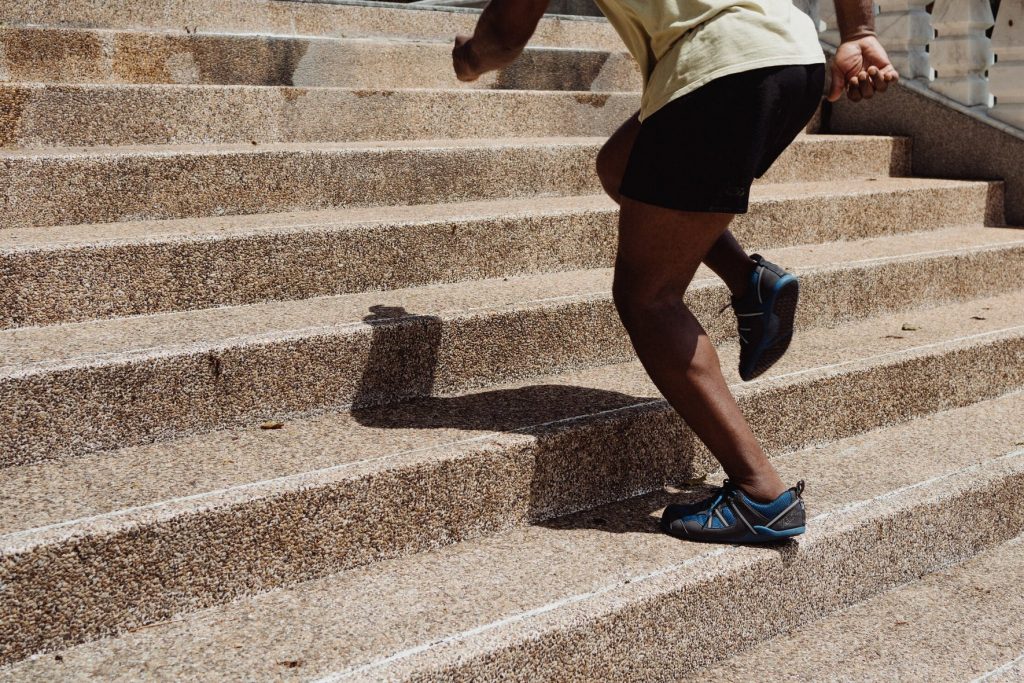Knowing how fit you are can help you set good fitness goals, see your progress and stay motivated. Most often, measures of fitness involve these key areas:
- Aerobic fitness, which involves how well the heart uses oxygen.
- Muscle strength and endurance, which involve how hard and long muscles can work.
- Flexibility, which is how able joints are to move through their full range of motion.
- Body composition, which involves how much fat, bone and muscle are in the body.
To do your assessment, you need:
- A stopwatch or a watch that can measure seconds.
- A cloth measuring tape.
- A scale.
- Someone to help you record your scores and count how many times you repeat something.
Aerobic fitness: Heart rate at rest
Your heart rate at rest is a measure of heart health and fitness. For most adults, a healthy heart rate is between 60 to 100 beats per minute.
To check your pulse at the blood vessel in the neck called the carotid artery, place your index and third fingers on your neck to the side of your windpipe.
To check your pulse at your wrist, place two fingers between the bone and the tendon over the blood vessel found on the thumb side of the wrist, called the radial artery.
Take your pulse for 15 seconds. Multiply this number by four to find out your beats per minute.
Aerobic fitness: Target heart rate zone
The target heart rate zone is a heart rate range that gives your heart and lungs a good workout. This zone ranges from 50% to 85% of the maximum heart rate (MHR) for your age. Aim for 50% to 70% of MHR when you do moderately intense activities and 70% to 85% of MHR when you do vigorous activities.

You can use the target heart rate zone as a guide to see how hard you’re exercising.
If you are on the lower end of your target heart rate zone, you can try to increase your effort little by little to get more from your workout.
If you exercise regularly, you can stop briefly to check your heart rate at times during an aerobic workout. If you don’t exercise regularly, you can do a simple test by checking your heart rate after a walk of about 10 minutes.
Target heart rate zone
| Age | Target heart rate zone: Beats per minute | Maximum heart rate: Beats per minute |
| 25 | 100-170 | 200 |
| 35 | 93-157 | 185 |
| 45 | 88-149 | 175 |
| 55 | 83-140 | 165 |
| 65 | 78-132 | 155 |
Aerobic fitness: Running or jogging test
Another way to test your aerobic fitness is to time yourself on a 1.5-mile (2.4-kilometer) run or jog. The following times show a good fitness level based on age and sex. A lower time most often means better aerobic fitness. A higher time suggests a need to do better.
Good fitness results based on timing of 1.5 mile (2.4km) run
| Age | Women: Time in minutes | Men: Time in minutes |
| 25 | 13 | 11 |
| 35 | 13.5 | 11.5 |
| 45 | 14 | 12 |
| 55 | 16 | 13 |
| 65 | 17.5 | 14 |
Muscular strength and endurance: Pushup test
Pushups can help you measure muscular strength and endurance. If you’re starting a fitness program, you can do pushups on your knees. If you can, do classic pushups. Follow these steps for both types:
- Lie facedown on the floor with your elbows bent and your palms next to your shoulders.
- Keep your back straight. Push up with your arms until your arms are at full length.
- Lower your body until your chin touches the floor.
- Do as many pushups as you can until you need to rest.
The following counts show a good fitness level based on age and sex. If your pushup count is below the target number, use the target as a goal to work toward. Counts above the targets mean better fitness.
Good fitness results for pushup counts
| Age | Women: Number of pushups | Men: Number of pushups |
| 25 | 20 | 28 |
| 35 | 19 | 21 |
| 45 | 14 | 16 |
| 55 | 10 | 12 |
| 65 | 10 | 10 |
Body composition: Body mass index (BMI)
Body mass index (BMI) shows whether you have a healthy amount of body fat. You can find your BMI with a BMI table or online calculator.
To do the calculation yourself, divide your weight in pounds by your height in inches squared. Then multiply by 703. Or divide your weight in kilograms by your height in meters squared. To get your height in meters, divide your height in centimeters by 100.
Interpretation of BMI results
| BMI | Weight Status |
| Below 18.5 | Underweight |
| 18.5 – 24.9 | Normal weight |
| 25.0 – 29.9 | Overweight |
| 30 and above | Obesity |
Recommended workout activity
- Aerobic activity. Get at least 150 minutes of moderate aerobic activity. Or get at least 75 minutes of vigorous aerobic activity a week. You can also get an equal mix of the two types. Aim to exercise most days of the week.
- Strength training. Do strength training exercises for all major muscle groups at least two times a week. One set of each exercise is enough for health and fitness benefits. Use a weight or resistance level heavy enough to tire your muscles after about 12 to 15 repetitions.
Moderate aerobic activity includes:
- Walking at a good pace.
- Water aerobics.
- Bicycling slower than 10 miles an hour on mostly level ground.
- Pushing a lawn mower, gardening or doing home repair.
Vigorous aerobic activity includes:
- Running.
- Swimming laps.
- Fast bicycling or biking hills.
- Jumping rope.
- Playing singles tennis.
Muscle-strengthening exercises include:
- Lifting weights or using resistance bands.
- Calisthenics that use body weight for resistance.
- Heavy gardening or yardwork.



